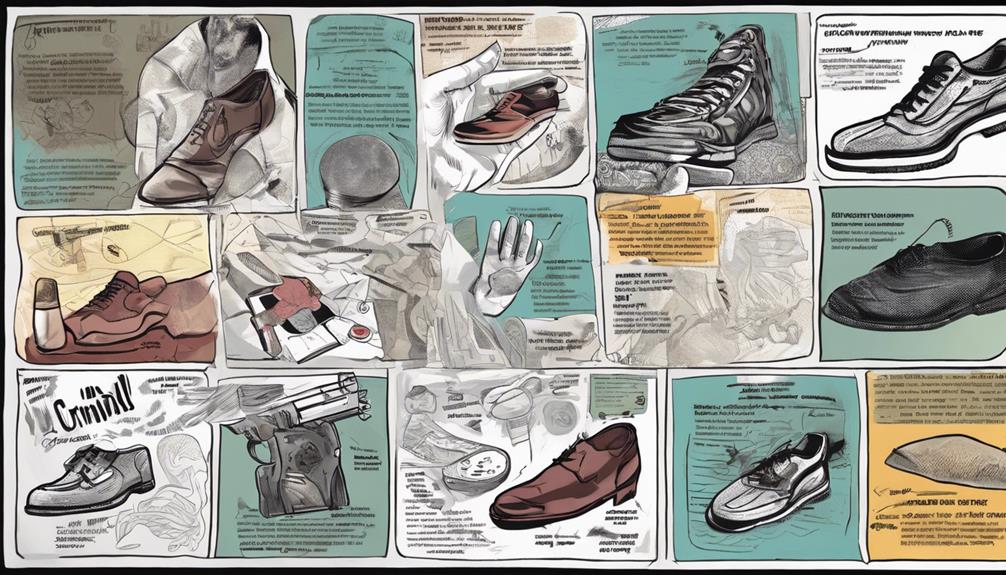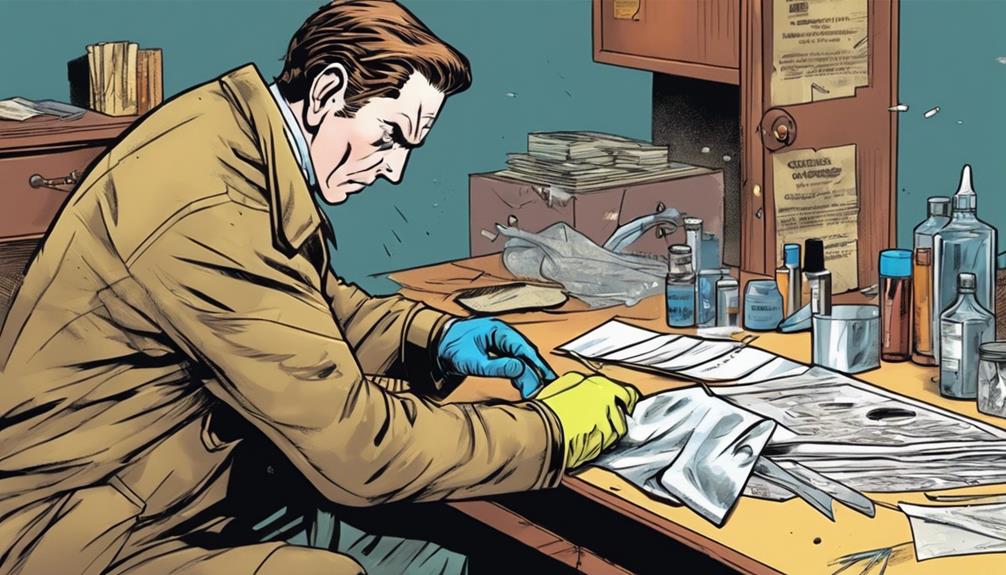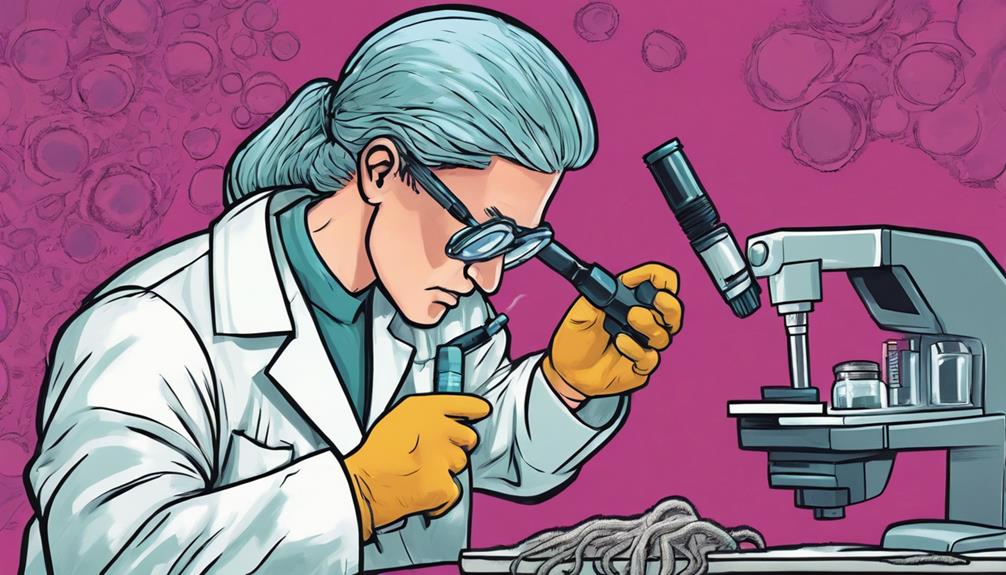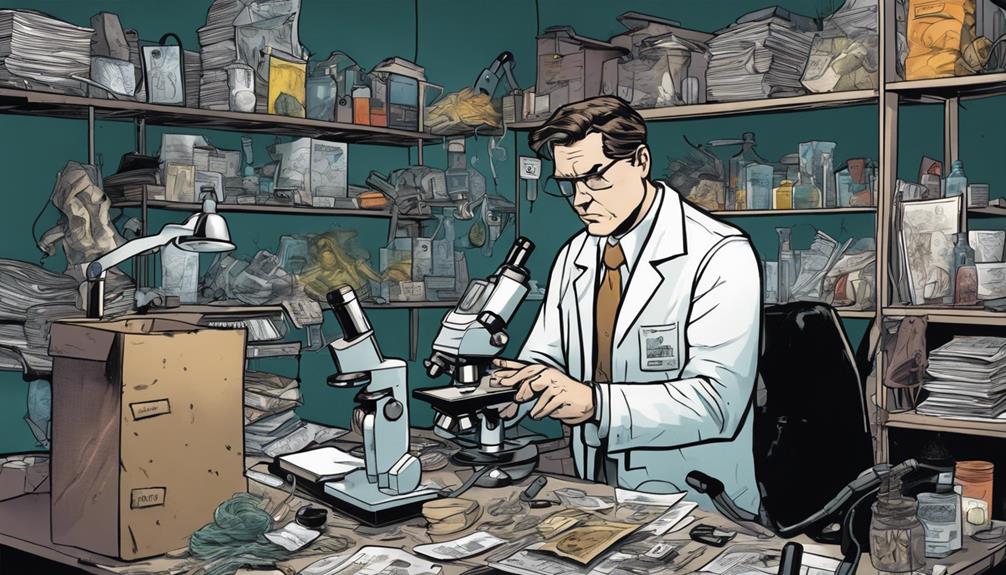In criminal investigations, individual evidence, like DNA profiles and fingerprints, acts as unique markers essential for identifying suspects and linking them directly to crime scenes or victims. These distinct traits aid investigators in narrowing down suspects and building strong cases by establishing a direct connection to the accused. Understanding individual evidence is vital for solving crimes efficiently and effectively. By recognizing these specific markers, investigators can piece together the puzzle of a case, ultimately leading to successful resolutions. Continuing will uncover further insights into the significance and role of individual evidence in criminal investigations.
Key Takeaways
- Individual evidence includes unique traits like DNA profiles, fingerprints, and handwriting characteristics for identification.
- It directly links a specific individual to a crime scene, aiding in narrowing down suspects.
- Specialized techniques are required to accurately identify distinct markers in individual evidence.
- Meticulous examination of unique characteristics helps establish direct links between suspects and crimes.
- Examples of individual evidence include DNA, fingerprints, handwriting, unique tool marks, and digital evidence.
Definition of Individual Evidence
Individual evidence, in criminal investigation, refers to physical evidence that can be traced back to a single source or person. This type of evidence plays a critical role in linking suspects to crime scenes or victims.
Examples of individual evidence include fingerprints, DNA, and handwriting. Such evidence is unique to a specific individual, making it invaluable in establishing connections within a case.
By analyzing trace evidence left behind at a crime scene, investigators can directly link this physical evidence to a particular person. This direct link helps build a stronger case against a suspect by providing concrete evidence of their involvement.
Essentially, individual evidence serves as a pivotal tool in criminal investigations, offering a clear connection between the evidence found and the person responsible. Understanding and analyzing individual evidence is essential for identifying perpetrators and bringing them to justice.
Characteristics of Individual Evidence

What distinct features set individual evidence apart in criminal investigations? Individual evidence is unique to a specific source, allowing for direct linkage to that particular individual or object. This type of evidence, such as DNA profiles, fingerprints, and handwriting characteristics, plays a pivotal role in establishing connections and identifying suspects in criminal cases. Analyzing individual evidence involves specialized techniques and comparison to known samples for accurate identification.
To better understand the characteristics of individual evidence, let's explore some common types and their significance in scientific evidence:
| Types of Evidence | Description | Importance in Investigations |
|---|---|---|
| DNA Profiles | Unique genetic information of an individual | Essential for precise identification |
| Fingerprints | Distinctive patterns left at a crime scene | Key for linking individuals to locations |
| Handwriting Characteristics | Individual writing traits for analysis | Helpful in determining authorship |
These types of scientific evidence provide crucial insights in criminal investigations, aiding in the process of solving cases and bringing justice to those involved.
Importance in Criminal Investigations

Individual evidence holds immense importance in criminal investigations as it can directly link a specific individual to a crime scene or victim. By providing unique characteristics like fingerprints and DNA, individual evidence plays a vital role in establishing the presence of a particular person in connection to a crime.
This type of evidence is essential for investigators to narrow down suspects, build strong cases, and present concrete links between the accused and the crime in court proceedings.
Evidence Significance Explained
Understanding the significance of evidence in criminal investigations is paramount as it forms the cornerstone of building a strong case against a suspect. Individual evidence plays a critical role in these investigations, especially in linking a specific person or object to a crime scene.
This type of evidence is pivotal and can help identify a particular source, like a specific weapon or tool used in a crime. By analyzing individual evidence such as fingerprints, DNA, or unique markings on objects, investigators can establish a direct connection between a suspect and the crime being investigated.
This direct link is essential in providing concrete evidence that can strengthen the case against the perpetrator. Therefore, the significance of individual evidence can't be overstated in criminal investigations, as it aids in establishing solid connections between suspects, victims, and the scenes of the crimes.
Role in Investigations
The importance of individual evidence becomes evident in criminal investigations due to its pivotal role in establishing direct connections between suspects and the crimes under scrutiny. Crime scene investigators rely on hard evidence such as fingerprints, DNA, fibers, and other unique trace materials to link a specific person or object to a crime scene or victim.
This type of evidence provides vital insights into the involvement or presence of individuals in criminal activities. By analyzing individual evidence, investigators can strengthen a case significantly, as it offers concrete proof of a suspect's association with the crime. Specialized techniques and expertise are required to accurately identify and interpret the distinct markers present in individual evidence.
Through the meticulous examination of these unique characteristics, investigators can establish a direct link between the suspect and the crime, aiding in the successful resolution of criminal cases.
Relevance to Cases
In criminal investigations, the significance of individual evidence is paramount for establishing direct connections between suspects and the crimes in question. This type of evidence, which can include DNA, fingerprints, shoeprints, and unique tool marks, plays an essential role in linking a specific person to a crime scene or victim. By presenting individual evidence collected from the scene, investigators can show a direct correlation between the suspect and the crime committed, making it an important part of the case presented in court.
To further understand the significance of individual evidence, let's look at a comparison table showcasing its importance in criminal investigations:
| Evidence Presented | Importance |
|---|---|
| DNA | Provides unique genetic link |
| Fingerprints | Directly links a person to a scene |
| Shoeprints | Connects a suspect to a specific location |
| Tool Marks | Links a particular tool to the crime |
| Clothing Fibers | Associates a person with the scene |
Examples of Individual Evidence

Individual evidence encompasses specific physical traits that can be traced back to a single source, such as DNA, fingerprints, and unique tool marks.
These examples play an essential role in criminal investigations by helping to pinpoint suspects or objects with precision.
Utilizing individual evidence can greatly bolster the strength of connections established in a case.
Types of Individual Evidence
When identifying types of individual evidence, consider examples such as DNA, fingerprints, handwriting, and unique tool marks. Each of these types plays an essential role in criminal investigations by providing unique identifiers that link a suspect to a crime scene or victim. Here is a breakdown of some common types of individual evidence:
| Type of Individual Evidence | Description |
|---|---|
| DNA | Genetic material unique to each individual, often collected from bodily fluids or hair. |
| Fingerprints | Unique patterns on the fingertips that can be lifted from surfaces at a crime scene. |
| Handwriting | Distinctive way of writing that can be compared to known samples for identification. |
| Unique Tool Marks | Impressions left by tools or objects that are unique to a specific tool, linking it to a crime. |
| Digital Evidence | Information stored electronically that can be used to establish a person's involvement in a crime. |
These types of individual evidence serve as vital pieces in the puzzle of solving criminal cases, providing investigators with concrete links to suspects and aiding in the pursuit of justice.
Significance in Investigations
How does individual evidence greatly impact criminal investigations?
Individual evidence plays a vital role in investigations as it provides specific links between the scene of the crime and potential suspects. This type of evidence must be unique to a particular person or object, such as DNA, fingerprints, handwriting, or tool marks.
By analyzing individual evidence found at the scene of the crime, investigators can narrow down their focus to specific individuals, helping to establish connections and build a strong case in court.
For instance, DNA evidence must be carefully collected and analyzed to match it to a specific individual, providing irrefutable proof of their presence at the crime scene. Similarly, unique tool marks or handwriting can be directly linked to a particular suspect, aiding in their identification and potential prosecution.
Role in Connecting Suspects

Utilizing individual evidence in criminal investigations plays an essential role in directly connecting suspects to specific items or locations at crime scenes. This type of evidence, such as DNA, fingerprints, or tool marks, is used to establish a direct link between a suspect and the crime.
By analyzing these unique characteristics, investigators can determine the involvement of a suspect with a high level of specificity. Types of individual evidence, like DNA profiles or distinct tool marks, provide a strong basis for connecting a suspect to the scene of the crime or the victim. This specificity helps build a compelling case against the suspect, highlighting their direct connection to the criminal activity.
Focusing on individual evidence allows investigators to narrow down their list of suspects and strengthen the connection between the crime and the perpetrator. To conclude, individual evidence serves as an important tool in connecting suspects to specific elements of a crime scene, aiding in the investigative process.
Collection and Preservation Methods

Properly collecting and preserving individual evidence is essential in maintaining its integrity and reliability for criminal investigations. When dealing with physical evidence, follow these steps to guarantee the evidence remains intact and admissible:
- Documentation: Carefully document the location, condition, and any observations related to the individual evidence. Detailed notes help establish the context and significance of the item.
- Packaging and Labeling: Use appropriate containers and packaging materials to prevent contamination or damage to the evidence. Label each item with essential information like the date, time, location, and collector's name.
- Chain of Custody: Maintain a strict chain of custody by tracking the possession of the evidence from collection to analysis. Properly documenting each transfer of the evidence helps ensure its reliability and admissibility in court.
Analysis Techniques for Individual Evidence

Analysis techniques for individual evidence are essential in determining key characteristics and identifying substances in criminal investigations. Microscopy allows investigators to closely examine trace evidence such as fibers, hairs, and glass fragments at a microscopic level. By using this technique, tiny details that might be vital in solving a case can be uncovered.
Spectroscopy aids in identifying the chemical composition of substances like drugs, explosives, and paint. This method is particularly useful when trying to link evidence to a specific source based on its unique chemical makeup.
Additionally, chromatography plays a significant role in separating complex mixtures for analysis, making it easier to identify substances like drugs or toxins.
DNA profiling stands out as a powerful technique that enables matching biological samples to individuals. Through DNA profiling, investigators can link suspects to crime scenes with a high degree of accuracy, helping to solve cases more effectively.
Limitations and Challenges

Understanding the limitations and challenges of individual evidence is essential in criminal investigations. When dealing with individual evidence, you need to navigate through some hurdles:
- Specificity: Individual evidence is highly specific, which can limit its ability to definitively link a suspect to a crime. This specificity requires precise matches for conclusive results.
- Contamination: Challenges arise due to the potential for contamination of individual evidence. Ensuring the integrity of the evidence is vital to prevent false conclusions.
- Availability: Individual evidence like DNA or unique tire tracks may not always be present or easily identifiable at a crime scene. Make sure to take into account the possibility of missing or hard-to-find evidence during investigations.
It's important to remember that while individual evidence plays a significant role, it's not always sufficient on its own. Combining it with other types of evidence strengthens a case and provides a more thorough understanding of the situation.
Admissibility in Court

In order to guarantee that evidence can be presented in legal proceedings, it must meet specific criteria regarding its relevance, authenticity, and reliability.
Admissibility in court refers to the standards that pieces of evidence need to meet to be considered valid for presentation during legal proceedings. Factors such as the evidence's connection to the case, its credibility, and how it was obtained all play a vital role in determining if it's admissible in court.
Evidence that's properly authenticated and directly related to the case at hand is more likely to be deemed admissible. The rules surrounding admissibility are in place to ensure that trials are fair and that only reliable and pertinent evidence is used to make legal decisions.
Excluding evidence that doesn't meet these criteria is essential for maintaining the fairness and integrity of the legal system, as it helps prevent the introduction of unreliable or prejudicial information into court proceedings.
Future of Individual Evidence in Investigations

Looking ahead, the evolution of individual evidence in investigations is poised to revolutionize how crimes are solved and justice is served. Advancements in forensic technologies and methodologies will shape the future landscape of criminal investigations. Here's what you can expect:
- Essential Accuracy: Continued development in forensic technologies, such as DNA analysis and advanced forensic techniques, will further improve the reliability and precision of individual evidence, ensuring more accurate conclusions in investigations.
- Increased Conviction Rates: The reliance on individual evidence as a cornerstone of modern investigations is expected to contribute to higher conviction rates. Unique identifiers provided by individual evidence, like fingerprints or DNA, play an essential role in narrowing down suspects and securing convictions.
- Improved Outcomes: As forensic technologies continue to advance, the future of individual evidence holds the promise of delivering more precise and conclusive investigative results. This won't only aid in solving crimes but also lead to improved outcomes in criminal cases, ultimately serving justice more effectively.
Frequently Asked Questions
What Is the Definition of Individual Evidence?
In criminal investigations, individual evidence is physical evidence that can be linked back to one specific source, like a person or object. It's unique to that source and can directly tie a suspect to a crime scene.
What Is Individual Vs Physical Evidence?
When distinguishing individual vs. physical evidence, remember that individual evidence links to a single source, like a unique fingerprint. Physical evidence is broader, encompassing all other types. Interesting fact: Individual evidence is present in 75% of solved cases.
What Are the Four Types of Evidence in a Criminal Investigation?
In a criminal investigation, you encounter four types of evidence: direct, circumstantial, testimonial, and physical evidence. Direct evidence proves a fact outright, while circumstantial evidence requires inference. Testimonial evidence stems from witness statements, and physical evidence includes tangible objects.
What Is an Example of Individual Evidence Quizlet?
In a quizlet, think of individual evidence like a DNA strand: unique, personal, and pinpointing. Examples include fingerprints, DNA, and distinct tool marks. These pieces link suspects to crimes with precision.
Conclusion
In summary, individual evidence plays a vital role in criminal investigations by providing unique characteristics that can link suspects to a crime scene.
From fingerprints to DNA samples, these pieces of evidence are like puzzle pieces that fit together to paint a clear picture of what happened.
As technology advances, the analysis of individual evidence will continue to improve, ensuring that justice is served and the guilty are held accountable for their actions.










